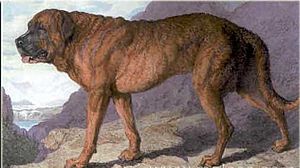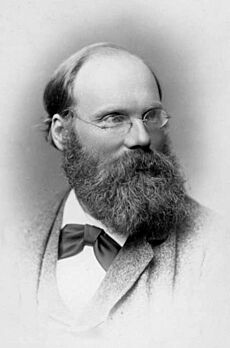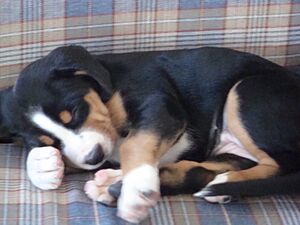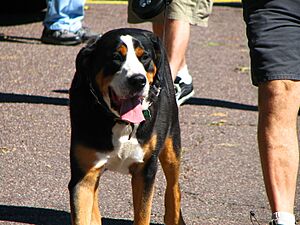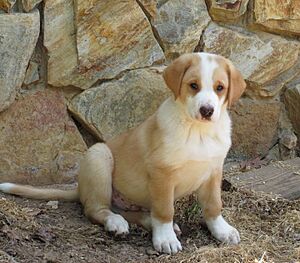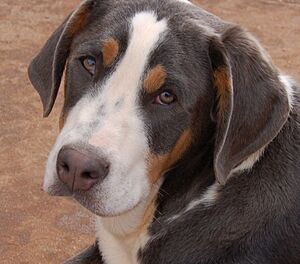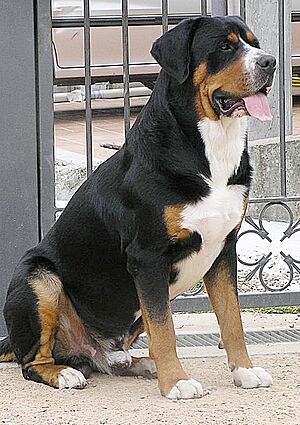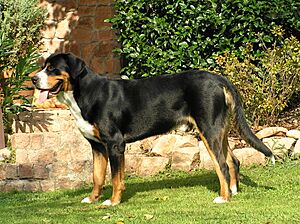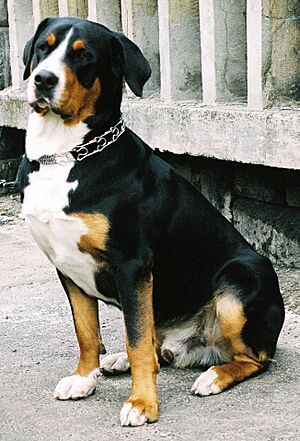Greater Swiss Mountain Dog facts for kids
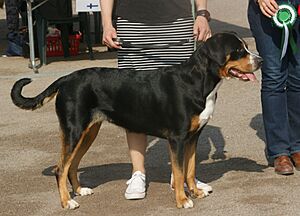 |
|||||||||||||||||||||||||||||
| Origin | Switzerland | ||||||||||||||||||||||||||||
|---|---|---|---|---|---|---|---|---|---|---|---|---|---|---|---|---|---|---|---|---|---|---|---|---|---|---|---|---|---|
|
|||||||||||||||||||||||||||||
|
|||||||||||||||||||||||||||||
| Domestic dog (Canis lupus familiaris) | |||||||||||||||||||||||||||||
The Greater Swiss Mountain Dog (also known as Grosser Schweizer Sennenhund in German or Grand Bouvier Suisse in French) is a large, friendly dog breed. These dogs come from the beautiful Swiss Alps.
The name Sennenhund means "dairy farmer's dog." This is because they helped people called Senn or Senner, who were dairy farmers and herders in the mountains.
These dogs likely came from local Swiss dogs mixing with big mastiff-type dogs. These mastiffs were brought to Switzerland by people who settled there long ago.
Sadly, by the late 1800s, it seemed like these dogs might disappear. Other breeds and new machines were doing their work. But luckily, people rediscovered them in the early 1900s. Today, they are known for their striking black, white, and rust-colored coats.
Among the four types of Swiss mountain dogs, the Greater Swiss Mountain Dog is the oldest. It is also the biggest of these four special breeds.
Contents
Discovering the Greater Swiss Mountain Dog
A Look at Their Past
The exact start of the Greater Swiss Mountain Dog is a bit of a mystery. For about 300 years, starting in 1515, the remote valleys of Switzerland were quite cut off from the rest of the world. During this time, people created specific dog breeds by carefully choosing which dogs to breed. They often gave puppies to neighbors and family.
Working Dogs of the Mountains
The Greater Swiss Mountain Dog was a fantastic working dog. They were especially good at pulling carts and herding animals in the mountains. Their strength and helpfulness earned them the nickname "the poor man's horse." This shows how important they were to families who needed help with farm work.
Bringing the Breed Back
A Champion for Swiss Dogs
By the late 1800s, many thought the Greater Swiss Mountain Dog was almost gone. Machines and other dog breeds were taking over their jobs. But in the early 1900s, a geology professor named Albert Heim helped bring them back.
Professor Heim was an expert on Sennenhund dogs. He encouraged people to take an interest in these wonderful animals. His efforts helped save the breed. In 1912, the first club was formed to support the Greater Swiss Mountain Dog. Thanks to people like Professor Heim, this breed and the Bernese Mountain Dog were saved from disappearing.
Growing in Popularity
By 1945, over 100 puppies were officially registered. This meant there were about 350 to 400 of these dogs around at that time.
The breed gained international recognition in 1939. This is when the Swiss Standard, which describes what the breed should look like, was first published. In 1968, the breed was brought to the U.S.
You might have even seen Greater Swiss Mountain Dogs in the media! For example, a dog named Network was a mascot for a big tech company. Another dog, Mouse, was a mascot for a "dog-friendly" group in Austin, Texas. Oscar the Grouch, a Greater Swiss Mountain Dog, was even featured in The Wall Street Journal before competing in a famous dog show. According to the AKC, they are quite popular, ranking 88th among all dog breeds.
What a Greater Swiss Mountain Dog Looks Like
These dogs are large and have strong bones. They have amazing physical strength, which made them excellent working dogs.
Their Special Coat
Greater Swiss Mountain Dogs have a beautiful tricolor coat. This means they have three main colors: black, white, and rust (a reddish-brown).
The top of their back, ears, tail, and most of their legs are black. You'll see rust-colored patches on their cheeks and above their eyes, like a "thumb print." Rust also appears on their legs, between the white and black areas. White markings are usually on their muzzle, feet, tail tip, and chest. A white stripe often runs from their muzzle up between their eyes.
For these working dogs, how well they can do their job and their personality are more important than perfect markings. People often say, "markings don't pull the cart." This means that looks are not as important as their ability to work.
They have a double coat. This means they have a dense outer coat that's about 1.25 to 2 inches (3 to 5 cm) long. Underneath, they have a thick undercoat. This thick coat helps them stay warm in the cold Swiss mountains. Because of this, they shed hair throughout the year, with a bigger shedding period once or twice a year.
While the standard color is black, white, and rust, you might sometimes see them in other colors. These can include blue, white, and tan (where blue replaces black and tan replaces rust). There are also rust and white bi-color dogs, which means they are rust and white with no black at all.
How Big Are They?
Male Greater Swiss Mountain Dogs usually stand between 25.5 and 28.5 inches (65 to 72 cm) tall at the shoulder. Females are a bit smaller, ranging from 23.5 to 27 inches (60 to 69 cm) tall.
There isn't a strict weight limit, but males typically weigh between 90 and 140 pounds (41 to 64 kg). Females usually weigh between 80 and 110 pounds (36 to 50 kg). They are slightly longer than they are tall.
Their Strong Build
Head and Eyes
Their eyes are shaped like almonds and can be hazel to dark brown. Dark brown is preferred. Their eyes are medium-sized and don't stick out or sink too deep.
Body Shape
Their chest is deep, about half the height of the dog at the shoulder. The deepest part of the chest should be between their elbows.
Powerful Legs
Their shoulders are strong and well-muscled. Their front legs are straight and powerful. Their back legs are broad, strong, and muscular. These powerful legs and strong joints are very important for a working dog. They help the dog push off the ground with great force when moving or pulling a cart.
A Friendly and Calm Temperament
The Greater Swiss Mountain Dog is known for being happy and enthusiastic. They love being around people and children. This breed is very sociable, active, calm, and dignified.
Even though they are big, they don't need a huge amount of space to live. They do need regular exercise to stay healthy and happy. These dogs often stay close to their owners, always checking in and rarely wandering far away.
Keeping Them Healthy
For such large dogs, Greater Swiss Mountain Dogs are generally quite healthy. They tend to have fewer health problems compared to some other very large breeds. Like all dogs, they need good care, a healthy diet, and regular vet check-ups to stay in top shape.
How Long Do They Live?
Larger dogs, like the Greater Swiss Mountain Dog, usually have shorter lifespans than smaller dogs. Most Greater Swiss Mountain Dogs live for about 8 to 11 years. A survey by the US breed club showed a median lifespan of about 6.75 years, but this can vary depending on many factors.
Official Recognition for the Breed
Many important dog organizations around the world recognize the Greater Swiss Mountain Dog:
- The Fédération Cynologique Internationale (FCI) recognized them internationally in 1939.
- The American Kennel Club (AKC) fully recognized the breed in 1995. They are part of the Working Group.
- The Canadian Kennel Club recognized them in 2006, also in the Working Group.
- The United Kennel Club recognized them in 1992, placing them in the Guardian Dog Group.
- The Kennel Club in the United Kingdom also classifies them in the Working Group.
The Four Sennenhund Breeds
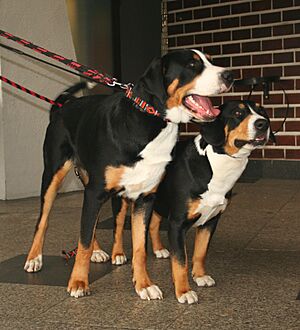
The Greater Swiss Mountain Dog is considered the oldest of the four Swiss mountain dog breeds. All four breeds share similar colors and markings, but they come in different sizes.
The four Sennenhund breeds are:
- Grosser Schweizer Sennenhund, or Greater Swiss Mountain Dog
- Berner Sennenhund, or Bernese Mountain Dog
- Appenzeller Sennenhund, or Appenzeller Mountain Dog
- Entlebucher Sennenhund, or Entlebucher Mountain Dog
Dogs Like the Greater Swiss Mountain Dog
Besides the other three Sennenhund breeds, Greater Swiss Mountain Dogs are related to other mountain dogs. These include Boxers, Bullmastiffs, Doberman Pinschers, Great Danes, Great Pyrenees, Komondors, Kuvaszes, and other mastiffs. This breed likely helped in the development of the famous St. Bernard and the Rottweiler.
See also
- List of dog breeds
- Carting


